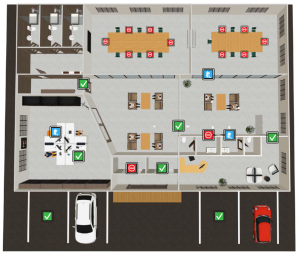
LoRa and EnOcean represent different approaches when selecting wireless standards for building automation and control. Which one is best for your smart building applications?
Author: Pete Smith, Head of Sales and Marketing at iaconnects
Two popular radio standards competing for building automation applications are LoRa (together with its wide-area network implementation, LoRaWAN) and the EnOcean wireless protocol. Both were developed to connect devices, usually sensors, using wireless communications and appropriate data transmission methods to form an IoT network. But the similarity is only on the surface.
The background to LoRa
LoRa stands for Long Range radio or, as the LoRa Alliance states: “providing low power, long-range connectivity within large-scale commercial implementations”. With up to a 16km signal range, there is an abundant range of applications for which this technology is well suited. It is the perfect technology for sending outdoor air quality data, parking availability data or meter readings signal from a smart meter to a central collection point potentially a few kilometers away, at a predefined frequency depending on the solution.
This begs the question as to whether a relatively slow-transmitting Long Range radio is well-suited for building automation. A LoRaWAN signal that travels 16km is many seconds long and very energy hungry. This seems like overkill for a typical building automation application such as switching on a light from a switch 5 meters away.
LoRa’s claim to suitability in building automation stems mainly from the fact that you do not need to install a large infrastructure of gateways or receivers in a large building. A signal can travel for example from the basement up to the 25th floor of a building. These long and energy-hungry signals are less than ideal for some building automation and control applications. The resulting latency is not only a user issue but also falls outside national lighting specifications in many cases.
The solution with LoRa is to increase the data rate, which basically has the physical consequence of decreasing the range: adjusting what LoRa calls “spreading factors” or SF. SF7 raises the data rate to 5kbps – so much that it effectively becomes a short-range radio in the ballpark of EnOcean, Bluetooth, ZigBee or Z-Wave. There are further issues that potentially limit LoRa’s credentials in building automation.
Even in the “short-range” SF7 mode, LoRa is energy-hungry compared to alternative IoT protocols, so running indoor products from low-cost energy harvesting sources is still a long way off. Nevertheless, ultralow-power devices can be used, but they still need batteries to operate.
However, The LoRaWAN® specification is a Low Power, Wide Area (LPWA) networking protocol designed to wirelessly connect battery-operated ‘things’ to the internet in regional, national or global networks, and targets key Internet of Things (IoT) requirements such as bi-directional communication, end-to-end security, mobility and localisation services. This means that if the primary use case is to collect valuable data such as outdoor air quality e.g. temperature, humidity, CO2, and the use case accepts powering the sensors with a cable or batteries (which will need to be replaced), then LoRa can be a suitable protocol.
Long-range over unlicensed radio makes it an ideal choice for specific applications like city-wide environmental sensors, streetlamp control and monitoring, smart parking, basic control units for agricultural farms and monitoring of small objects.
A battery-free alternative
Unlike LoRa, the EnOcean wireless protocol was designed from the outset with self-powered devices in mind, and a specific focus on building automation.
In Europe, EnOcean operates on 868.3 MHz, which is well-suited to transmitting short data packets at a rate of 125 kbit/s. EnOcean benefits from extremely short latency times which, in practice, cannot be sensed even when using time-critical devices such as switches. Its indoor range of around 30m is more than adequate for most smart buildings. Moreover, the EnOcean protocol is internationally recognized as ISO/IEC standard, so a high degree of interoperability is guaranteed across devices from a broad range of suppliers from the EnOcean Alliance – an open, non-profit organization – which benefits from more than 400 members, many of them operating in the field of building automation.
EnOcean devices can communicate directly amongst themselves within an overriding infrastructure. Plus, the integration of EnOcean devices in building automation (DDC system) controllers is facilitated by the provision of EnOcean interfaces by many manufacturers; alternatively, other gateway solutions (e.g. EnOcean-IP, EnOcean-KNX, EnOcean-DALI, etc.) are available. A broad range of sensors for building automation applications is readily available from multiple suppliers.
Going beyond consumer home automation, EnOcean provides an ecosystem that is ideal for professional high-quality, highly reliable operations, maintenance-free over decades. Installed in millions of buildings during the 20 years since the protocol was standardised, it has delivered its promises of a low carbon footprint and low electro-smog.
Use cases highlight pros and cons
Established ecosystems can be compared objectively by assessing their ability to meet not only the requirements for a range of use cases but also the requirements arising in terms of establishing, operating and maintaining the necessary infrastructure.
In his milestone study of technologies for automation and control, Prof. Dr. Michael Krödel from IGT (“Institute for Building Technologies”) in Germany observes that wireless standards for integrating sensors in automation and control applications will find ever-growing opportunities in the field of building automation. The study takes as its starting point the requirements for room automation and facility automation on the one hand, and the requirements for “Smart Buildings” on the other. Prof. Krödel considered eight criteria to give an overall score of suitability from 0 to 2.
On this basis, technologies based on unsuitable frequency bands (“KO” criterion) scored 0. LoRa gets a medium rating, losing points for its unnecessary large data packet size and excessive range with SF7. EnOcean gained the maximum possible ranking, with data transmission rates, range and latency times well inside the required range.
Infrastructures are up to the mark
Both protocols are in the middle bracket regarding the suitability of their infrastructure. For LoRa, backbone infrastructure is required for the integration of sensor data. LoRa networks are used in some urban areas as an alternative, provider-dependent solution. With LoRaWAN and EnOcean, sensor data can be integrated with IoT infrastructure solutions such as MobiusFlow®, building automation controllers (DDC systems) either directly or via IP-based networks.

MobiusFlow is an IoT Edge Platform developed over the past 15 years by IAconnects Technology Ltd (iaconnects) to allow non-manufacturer-specific connectivity of the internet of things (IoT) to the cloud or local computers. It can work in the cloud, on closed secure networks, Wi-Fi-based systems or utilise its own data connection (3G/4G) when used in conjunction with IA’s custom hardware. You can find out more about MobiusFlow here.
Energy harvesting – a significant advantage
EnOcean’s focus on self-powered energy harvesting devices offers a further advantage over competitors in building automation. All its devices fulfill the suitability criterion, whilst other protocols including LoRa mainly rely on mains or battery power, providing many fewer options for working with self-powered devices. This means that there is a higher carbon footprint and also the necessity to pull cables or maintain batteries.
Sensors for building automation are increasingly available for LoRa-based solutions, but LoRa actuators remain scarce. By contrast, the EnOcean Alliance’s broad range of sensors provides myriad opportunities. In addition, EnOcean scores highly in its provision for measurement and testing, offering dedicated equipment and relevant documentation: both readily available and easy-to-use. T&M solutions are likewise available for LoRa.
Finally, despite the caveats pertaining to long-range LoRaWAN transmission, both protocols demonstrate solid security from individual sensors to complete building automation solutions. EnOcean and LoRaWAN are both suitable for data encryption and provide effective security throughout the building network.
EnOcean and LoRaWAN? Can they work together in perfect harmony?
The overall result is that EnOcean proved “Eminently suited for building automation applications.”, with only its backbone infrastructure requirement marring a perfect score. However, LoRaWAN is perfectly suited to building monitoring solutions where cable power is available or battery maintenance is acceptable in the application.
Utilising multiple protocols such as EnOcean for indoor building automation and LoRaWAN for outdoor monitoring, allows you to choose the best devices on a solution-by-solution basis. There are benefits such as low power consumption, bi-directional communication as well as end-to-end security, mobility and localisation services, which can be combined into MobiusFlow and therefore a single efficient system.



 English
English  Deutsch
Deutsch  简体中文
简体中文  Français
Français  Italiano
Italiano 
